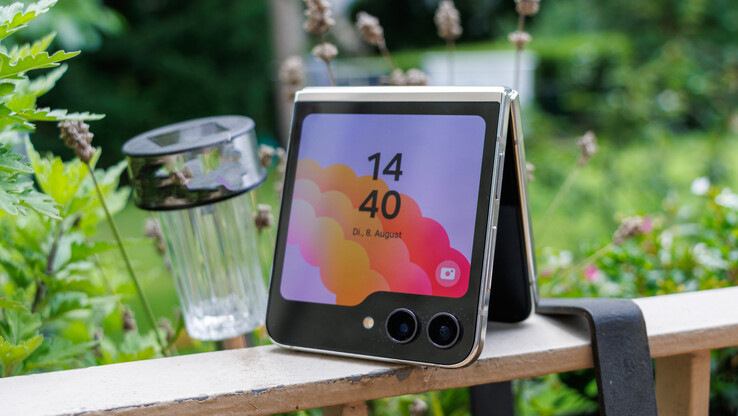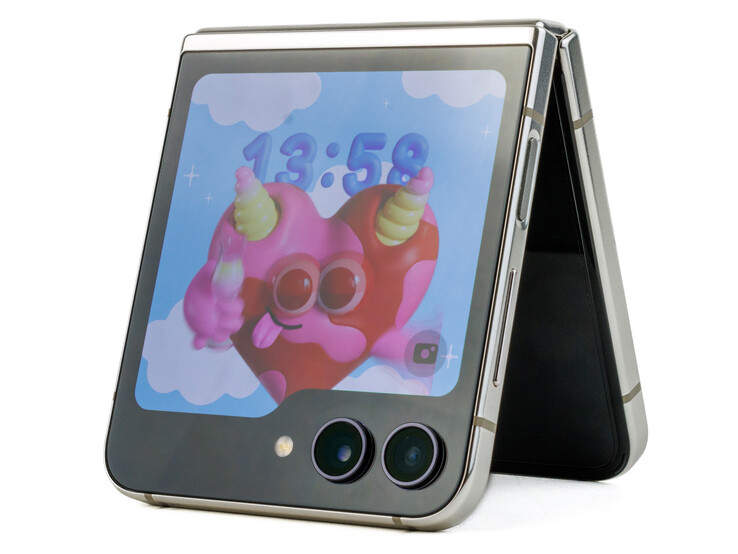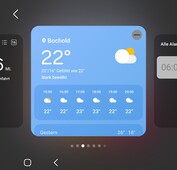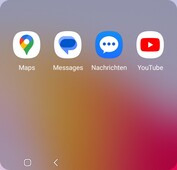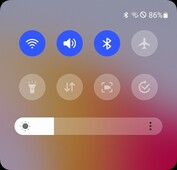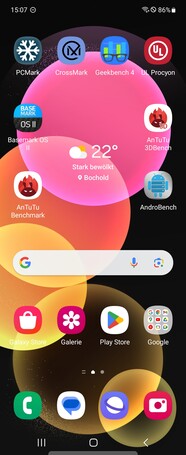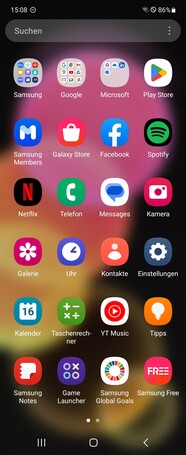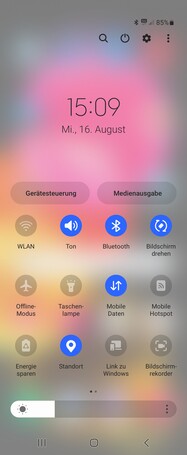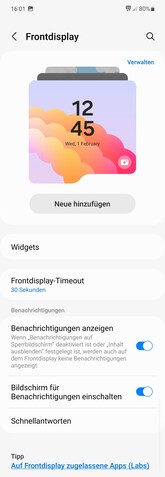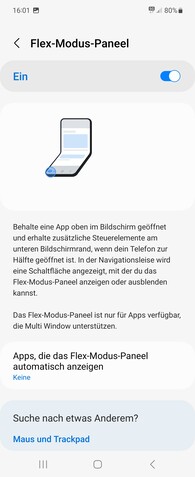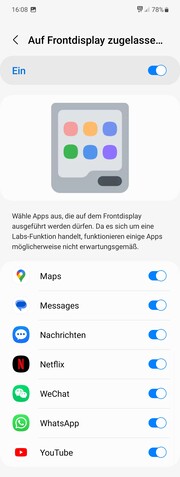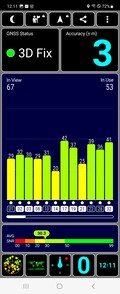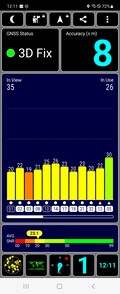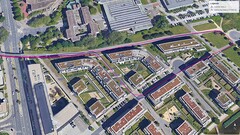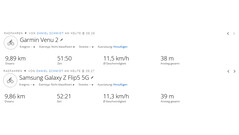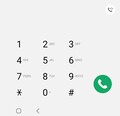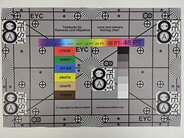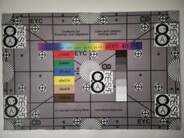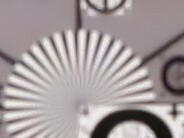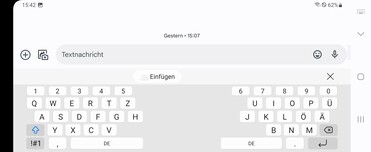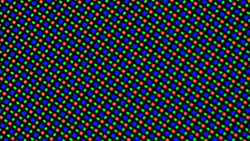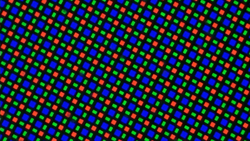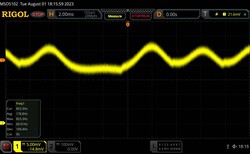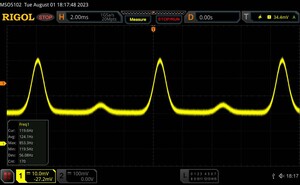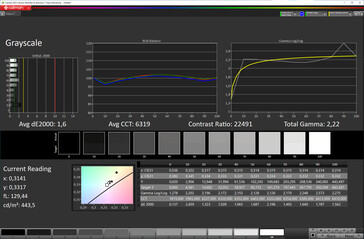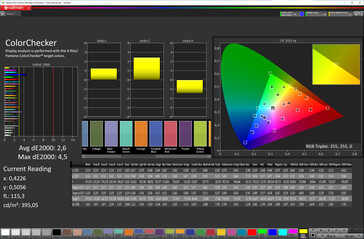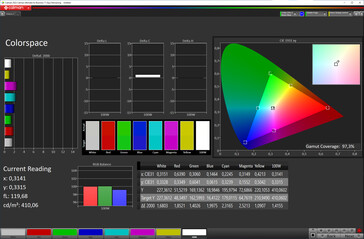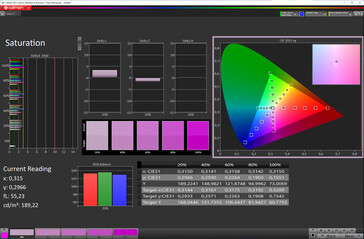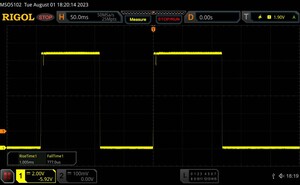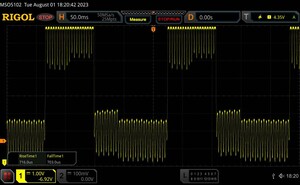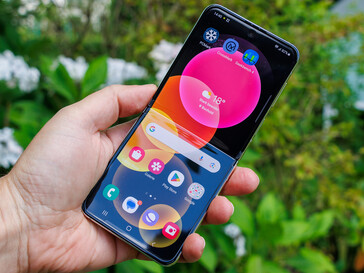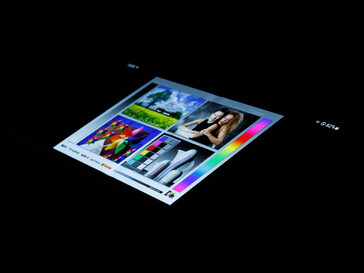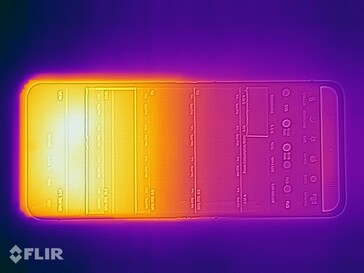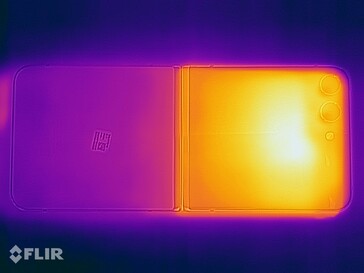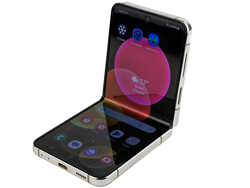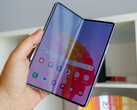Samsung Galaxy Z Flip5 5G review - The foldable phone with a large cover display
The Samsung Galaxy Z Flip5 5G is the successor to the Galaxy Z Flip4 and its biggest visual difference is its much bigger outer display. Furthermore, the small gap which used to be seen when the phone was folded shut has now been fixed.
In this review, you can read about what else this foldable smartphone has to offer and whether it makes sense to upgrade from the Flip4.
Possible competitors compared
Rating | Date | Model | Weight | Drive | Size | Resolution | Best Price |
|---|---|---|---|---|---|---|---|
| 86.9 % | 08/2023 | Samsung Galaxy Z Flip5 5G SD 8 Gen 2 for Galaxy, Adreno 740 | 187 g | 256 GB UFS 4.0 Flash | 6.70" | 2640x1080 | |
| 87 % | 06/2023 | Motorola Razr 40 Ultra SD 8+ Gen 1, Adreno 730 | 188.5 g | 256 GB UFS 3.1 Flash | 6.90" | 2640x1080 | |
| 87.9 % | 10/2022 | Samsung Galaxy Z Flip4 5G SD 8+ Gen 1, Adreno 730 | 187 g | 128 GB UFS 3.1 Flash | 6.70" | 2640x1080 | |
| 86.1 % | 03/2022 | Huawei P50 Pocket SD 888 4G, Adreno 660 | 190 g | 512 GB UFS 3.1 Flash | 6.90" | 2790x1188 | |
| 88.7 % | 07/2023 | Asus Zenfone 10 SD 8 Gen 2, Adreno 740 | 172 g | 512 GB UFS 4.0 Flash | 5.90" | 2400x1080 |
Case - The Galaxy Z Flip5 comes with a new flexible hinge
The Galaxy Z Flip5 is nearly identical in size to its predecessor, except now it is up to two millimetres slimmer when folded shut (85.1 x 71.9 x 15.1 mm). This is thanks to its new flex hinge which allows the phone's corners to lie flat together when it is folded shut. As a result of the small plastic spacers, there still remains a tiny gap which can let dust particles in.
In our test, the Galaxy Z Flip5's build impressed us. Its gap dimensions are even and its armored aluminum looks very high-quality and stable. The outside is protected by Corning Gorilla Glas Victus 2 and the foldable Samsung phone is waterproof (IPX8 certified). You just have to be careful while trying to bend the phone when it is folded open, as it makes audible cracking noises and the hinge allows for quite a bit of movement.
The flex hinge's flexible opening angle is particularly great, which allows for the display to be held very stably in place between 44 and 180 degrees. The Flip5 is available in the colors Mint, Graphite, Lavender and Cream. The Samsung store exclusives (gray, blue, green and yellow) all have a matte black aluminum frame.
Connectivity - Now including USB 3.2
Different to its predecessor, this Samsung phone now has a minimum of 256 GB of internal storage, but it's also about US$100 more. There is now also a variant which has 512 GB. The phone doesn't have a microSD card slot.
The Galaxy Z Flip5 now features the faster USB 3.2 (gen 1). In our copying test, it achieved only average transfer rates (217 MB/s), although this is still a lot faster than USB 2.0.
The phone also includes NFC and Bluetooth 5.3 - you'll unfortunately still have to make do without UWB.
Software - Outer display with improved operation
The Galaxy Z Flip5 5G uses Android 13 with the Samsung user interface One UI 5.1.1 which, at the time of testing, had an up-to-date security patch installed from 1st August 2023. This will remain for quite some time, as the foldable phone is set to receive these monthly patches for four years - and after that, every quarter for a further year. Furthermore, the Flip5 is set to receive four major upgrades, meaning up to Android 17.
The outer display has been treated to the biggest software updates: It is now not only larger, but it also has a full capacitive touchscreen with new widgets. Unfortunately, we couldn't run all apps natively on this display, but you can run apps such as Google Maps and WhatsApp. With the help of a small keyboard, you can actually reply to Messenger messages directly via the outer display. You just have to activate this feature via Labs.
Communication and GNSS - The Galaxy Z Flip5 has precise location services
The Samsung Galaxy Z Flip5 supports Wi-Fi 6E and, as a result, tri-band WLAN connectivity. Together with our reference router, the Asus ROG Rapture GT-AXE11000, the phone achieved high and stable transmission rates via 5.0 and 6.0 GHz.
When using mobile data, the Samsung smartphone supports all the usual mobile network standards and can access a wide range of frequency bands. During our test, the device proved to have no reception difficulties in bigger cities and we had nothing at all to complain about.
| Networking | |
| Samsung Galaxy Z Flip5 5G | |
| iperf3 receive AXE11000 |
|
| iperf3 transmit AXE11000 |
|
| iperf3 transmit AXE11000 6GHz |
|
| iperf3 receive AXE11000 6GHz |
|
| Motorola Razr 40 Ultra | |
| iperf3 transmit AXE11000 6GHz |
|
| iperf3 receive AXE11000 6GHz |
|
| Samsung Galaxy Z Flip4 5G | |
| iperf3 receive AXE11000 |
|
| iperf3 transmit AXE11000 |
|
| Huawei P50 Pocket | |
| iperf3 receive AXE11000 |
|
| iperf3 transmit AXE11000 |
|
| Asus Zenfone 10 | |
| iperf3 transmit AXE11000 6GHz |
|
| iperf3 receive AXE11000 6GHz |
|
| Average of class Smartphone | |
| iperf3 receive AXE11000 |
|
| iperf3 transmit AXE11000 |
|
| iperf3 transmit AXE11000 6GHz |
|
| iperf3 receive AXE11000 6GHz |
|
The Samsung Galaxy Z Flip5 5G can access all the usual satellite networks in order to determine your location and it can even do so relatively quickly indoors. Outside, this happens almost instantaneously and with great accuracy.
On a small bike trip, we compared the Samsung phone with the Garmin Venu 2. Over the course of our almost 10-kilometre test route, both devices only had a 30-metre deviation from each other. The fitness smartwatch might have been a little more precise, but the Flip5 was definitely still able to record our route really well.
Telephoning features and call quality
The voice quality of the Galaxy Z Flip5 sounded very natural in our test and background noise was reliably filtered out. Especially surrounded by many people, these were not audible for the caller. Samsung's smartphone reverberates a tiny bit during hands-free calls, but this does not occur during video calls.
Features such as WLAN telephoning and VoLTE are supported. Phone calls can also be controlled via the external display to a limited extent: Your contact list can be accessed directly via a widget or you can use the keypad, and up to six favorites can be stored on another widget.
Cameras - Good dual camera and handy front viewfinder
The Galaxy Z Flip5's traditional front-facing camera is situated on the inside, above the foldable display. Photos taken using this lens are average, but it is good enough for video calls. You can achieve much better selfies if you use the phone's main setup. The outer display can then be used as a viewfinder. In everyday use, this works well and photos look much better. We don't completely understand why videos are limited to 60 FPS and in Full HD in this situation, as the cameras supposedly all support Ultra HD at up to 60 FPS.
The dual cameras are technically seen identical to the Galaxy Z Flip4, but they are apparently able to deliver better photos thanks to its more powerful IPS. In daylight, the Samsung phone takes great photos which depict colors vividly. Its ultra-wide angle lens is okay, but toward the edges, images have a tendency to become a little fuzzy and they show a few image errors. The phone's zoom is fine up to 2x, anything beyond that is unusable. You can achieve a maximum digital zoom of 10x.
Image Comparison
Choose a scene and navigate within the first image. One click changes the position on touchscreens. One click on the zoomed-in image opens the original in a new window. The first image shows the scaled photograph of the test device.
Main cameraMain cameraUltra-wide angle5x zoomLow light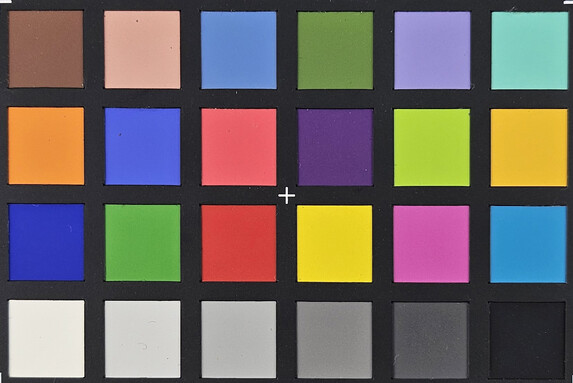
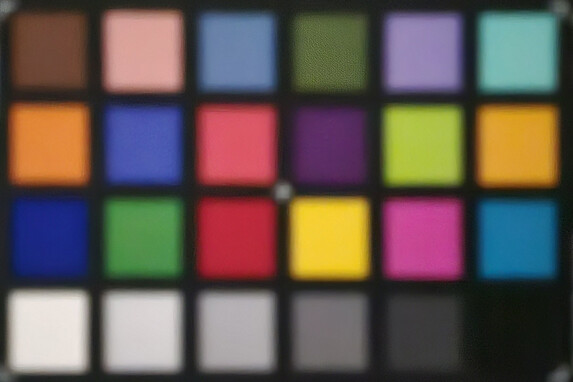
Scope of delivery and warranty - The Galaxy smartphone is packaged in a slim box
The Galaxy Z Flip5 5G only comes with a SIM tool and a USB-C cable. Wireless and wired power adapters as well as numerous protective cases can optionally be purchased from Samsung or third-party suppliers.
The Flip5 has a one-year warranty in the United States, which can be extended via Samsung's Care+ insurance package for between US$129 and US$329.
Input devices & operation - The Flip5 has a small keyboard
Both of the Galaxy Z Flip5's touchscreens behaved very reliably and without any issues during our test. As the outer display only has a refresh rate of 60 Hz, animations don't look quite as silky smooth as on the phone's inner display. The adapted keyboard which can be used on the small screen actually works quite well. It's just a shame that the display doesn't adapt to the device's positioning.
A fingerprint sensor housed within the power button takes care of biometric security. It works quite quickly and reliably, although it is advisable to touch your finger to the scanner a further time while the sensor is rotated, as it sometimes doesn't work as accurately when the phone is folded shut. You can also make use of facial recognition and, in contrast to the Pixel Fold, you can use it when the phone is folded shut or open. On the other hand, it is a little less secure.
Displays - OLEDs with a brightness of up to 1,666 cd/m²
The Galaxy Z Flip5's foldable display is the same size as the Flip4 and is only minimally brighter when it depicts pure white and is controlled by the ambient light sensor. In this case, it reaches an average of 848 cd/m² with a peak of 1,666 cd/m² (APL18). If you control the brightness manually, then the phone can reach up to 415 cd/m² - when using the setting additional brightness, you can get brightness levels up to 705 cd/m².
The smaller cover display can get a bit brighter (pure white depiction, active ambient light sensor) - up to 947 cd/m² in the centre of the picture. During the APL18 measurement, it held back a little and achieved only 1,296 cd/m² - below the 1,600 nits which Samsung claims the display can reach. Without the sensor, you can expect brightness levels up to 409 cd/m².
The Galaxy Z Flip5's display also shows signs of OLED flickering which is typical for this screen type. The foldable panel showed a very consistent frequency of 120 Hz in our test, which isn't necessarily high, but it has a low modulation degree and an even amplitude course, which is why only a very small number of people may have issues with the screen. This will likely only be a problem for extremely sensitive people. The cover display is a bit different: Here, the frequency is higher, but the amplitude curve is very unsteady and the modulation level is even higher, which can become straining for the eyes.
| |||||||||||||||||||||||||
Brightness Distribution: 97 %
Center on Battery: 836 cd/m²
Contrast: ∞:1 (Black: 0 cd/m²)
ΔE Color 2.6 | 0.5-29.43 Ø5
ΔE Greyscale 1.6 | 0.57-98 Ø5.3
97.3% sRGB (Calman 2D)
Gamma: 2.22
| Samsung Galaxy Z Flip5 5G Dynamic AMOLED, 2640x1080, 6.70 | Samsung Galaxy Z Flip5 5G Super AMOLED, 720x748, 3.40 | Motorola Razr 40 Ultra P-OLED, 2640x1080, 6.90 | Samsung Galaxy Z Flip4 5G Dynamic AMOLED , 2640x1080, 6.70 | Huawei P50 Pocket Foldable OLED, 2790x1188, 6.90 | Asus Zenfone 10 AMOLED, 2400x1080, 5.90 | |
|---|---|---|---|---|---|---|
| Screen | 7% | -53% | 17% | 12% | -16% | |
| Brightness middle | 836 | 947 13% | 849 2% | 795 -5% | 780 -7% | 797 -5% |
| Brightness | 848 | 915 8% | 830 -2% | 800 -6% | 768 -9% | 789 -7% |
| Brightness Distribution | 97 | 96 -1% | 96 -1% | 97 0% | 96 -1% | 93 -4% |
| Black Level * | ||||||
| Colorchecker dE 2000 * | 2.6 | 3.02 -16% | 1 62% | 1.1 58% | 3.64 -40% | |
| Colorchecker dE 2000 max. * | 4.5 | 7.61 -69% | 2.5 44% | 3.1 31% | 1.92 57% | |
| Greyscale dE 2000 * | 1.6 | 5.3 -231% | 1.5 6% | 1.6 -0% | 3.1 -94% | |
| Gamma | 2.22 99% | 2.198 100% | 2.37 93% | 2.23 99% | 2.238 98% | |
| CCT | 6319 103% | 6338 103% | 6466 101% | 6483 100% | 6531 100% |
* ... smaller is better
Screen Flickering / PWM (Pulse-Width Modulation)
| Screen flickering / PWM detected | 120 Hz | ||
The display backlight flickers at 120 Hz (worst case, e.g., utilizing PWM) . The frequency of 120 Hz is very low, so the flickering may cause eyestrain and headaches after extended use. In comparison: 53 % of all tested devices do not use PWM to dim the display. If PWM was detected, an average of 17903 (minimum: 5 - maximum: 3846000) Hz was measured. | |||
Measurement series with fixed zoom level and different brightness settings (foldable display)
We analyzed how accurately the Galaxy Z Flip5 displays colors on the foldable screen using Calman. The best results are achieved using the natural screen mode, which uses the sRGB color space and only deviates visibly from the target in colors when it comes to larger blue portions. As a result, the display is still very well calibrated, but a bit less accurate than in the Flip4.
Display Response Times
| ↔ Response Time Black to White | ||
|---|---|---|
| 1.78 ms ... rise ↗ and fall ↘ combined | ↗ 1.005 ms rise | |
| ↘ 0.777 ms fall | ||
| The screen shows very fast response rates in our tests and should be very well suited for fast-paced gaming. In comparison, all tested devices range from 0.1 (minimum) to 240 (maximum) ms. » 5 % of all devices are better. This means that the measured response time is better than the average of all tested devices (21.5 ms). | ||
| ↔ Response Time 50% Grey to 80% Grey | ||
| 1.42 ms ... rise ↗ and fall ↘ combined | ↗ 0.716 ms rise | |
| ↘ 0.703 ms fall | ||
| The screen shows very fast response rates in our tests and should be very well suited for fast-paced gaming. In comparison, all tested devices range from 0.2 (minimum) to 636 (maximum) ms. » 3 % of all devices are better. This means that the measured response time is better than the average of all tested devices (33.7 ms). | ||
The Galaxy Z Flip5 makes a good impression outdoors and remains easy to read even on bright days.
We like the foldable display's viewing-angle stability, but a delicate green haze is already visible at slight angles. However, this should not be annoying in everyday use.
Performance - Snapdragon 8 Gen 2 for Galaxy inside the Flip5
With the Snapdragon 8 Gen 2 for Galaxy, the Galaxy Z Flip5 has received the currently fastest SoC which should even be slightly faster than the regular model due to the prime core receiving a small clock boost. However, that is usually not the case, especially when a lot of performance is demanded - likely due to its too-weak cooling.
Nevertheless, Samsung's smartphone delivered good results in the benchmarks, which is also reflected in smooth system performance.
| UL Procyon AI Inference for Android - Overall Score NNAPI | |
| Samsung Galaxy Z Flip4 5G | |
| Average of class Smartphone (207 - 84787, n=150, last 2 years) | |
| Samsung Galaxy Z Flip5 5G | |
| Asus Zenfone 10 | |
| Motorola Razr 40 Ultra | |
| Average Qualcomm Snapdragon 8 Gen 2 for Galaxy (1267 - 16702, n=8) | |
| AImark - Score v3.x | |
| Average Qualcomm Snapdragon 8 Gen 2 for Galaxy (1216 - 156427, n=6) | |
| Average of class Smartphone (298 - 245629, n=105, last 2 years) | |
| Asus Zenfone 10 | |
| Motorola Razr 40 Ultra | |
The Adreno 740 which is installed in the Galaxy Z Flip5 is the fastest graphics unit for Android smartphones. While the new SoC may deliver better performance than its predecessor, it left more to be desired during most of the tests. Here, its weak cooling seems to be the limiting factor, too.
GFXBench (DX / GLBenchmark) 2.7: T-Rex Onscreen | 1920x1080 T-Rex Offscreen
GFXBench 3.0: on screen Manhattan Onscreen OGL | 1920x1080 1080p Manhattan Offscreen
GFXBench 3.1: on screen Manhattan ES 3.1 Onscreen | 1920x1080 Manhattan ES 3.1 Offscreen
GFXBench: on screen Car Chase Onscreen | 1920x1080 Car Chase Offscreen | on screen Aztec Ruins High Tier Onscreen | 2560x1440 Aztec Ruins High Tier Offscreen | on screen Aztec Ruins Normal Tier Onscreen | 1920x1080 Aztec Ruins Normal Tier Offscreen | 3840x2160 4K Aztec Ruins High Tier Offscreen
| 3DMark / Solar Bay Score | |
| Samsung Galaxy Z Flip5 5G | |
| 3DMark / Solar Bay Unlimited Score | |
| Samsung Galaxy Z Flip5 5G | |
| 3DMark / Wild Life Extreme Unlimited | |
| Asus Zenfone 10 | |
| Samsung Galaxy Z Flip5 5G | |
| Samsung Galaxy Z Flip4 5G | |
| Motorola Razr 40 Ultra | |
| Huawei P50 Pocket | |
| 3DMark / Wild Life Extreme | |
| Asus Zenfone 10 | |
| Samsung Galaxy Z Flip5 5G | |
| Samsung Galaxy Z Flip4 5G | |
| Motorola Razr 40 Ultra | |
| Huawei P50 Pocket | |
| 3DMark / Wild Life Unlimited Score | |
| Samsung Galaxy Z Flip4 5G | |
| Motorola Razr 40 Ultra | |
| Samsung Galaxy Z Flip5 5G | |
| Huawei P50 Pocket | |
| 3DMark / Sling Shot Extreme (ES 3.1) Unlimited Physics | |
| Samsung Galaxy Z Flip5 5G | |
| Huawei P50 Pocket | |
| Samsung Galaxy Z Flip4 5G | |
| 3DMark / Sling Shot Extreme (ES 3.1) Unlimited Graphics | |
| Samsung Galaxy Z Flip5 5G | |
| Samsung Galaxy Z Flip4 5G | |
| Huawei P50 Pocket | |
| 3DMark / Sling Shot Extreme (ES 3.1) Unlimited | |
| Samsung Galaxy Z Flip5 5G | |
| Samsung Galaxy Z Flip4 5G | |
| Huawei P50 Pocket | |
| GFXBench (DX / GLBenchmark) 2.7 / T-Rex Onscreen | |
| Motorola Razr 40 Ultra | |
| Asus Zenfone 10 | |
| Samsung Galaxy Z Flip5 5G | |
| Samsung Galaxy Z Flip4 5G | |
| Huawei P50 Pocket | |
| GFXBench (DX / GLBenchmark) 2.7 / T-Rex Offscreen | |
| Samsung Galaxy Z Flip5 5G | |
| Asus Zenfone 10 | |
| Samsung Galaxy Z Flip4 5G | |
| Motorola Razr 40 Ultra | |
| Huawei P50 Pocket | |
| GFXBench 3.0 / Manhattan Onscreen OGL | |
| Asus Zenfone 10 | |
| Samsung Galaxy Z Flip5 5G | |
| Motorola Razr 40 Ultra | |
| Samsung Galaxy Z Flip4 5G | |
| Huawei P50 Pocket | |
| GFXBench 3.0 / 1080p Manhattan Offscreen | |
| Asus Zenfone 10 | |
| Samsung Galaxy Z Flip5 5G | |
| Motorola Razr 40 Ultra | |
| Samsung Galaxy Z Flip4 5G | |
| Huawei P50 Pocket | |
| GFXBench 3.1 / Manhattan ES 3.1 Onscreen | |
| Asus Zenfone 10 | |
| Samsung Galaxy Z Flip5 5G | |
| Motorola Razr 40 Ultra | |
| Samsung Galaxy Z Flip4 5G | |
| Huawei P50 Pocket | |
| GFXBench 3.1 / Manhattan ES 3.1 Offscreen | |
| Asus Zenfone 10 | |
| Samsung Galaxy Z Flip5 5G | |
| Motorola Razr 40 Ultra | |
| Samsung Galaxy Z Flip4 5G | |
| Huawei P50 Pocket | |
| GFXBench / Car Chase Onscreen | |
| Asus Zenfone 10 | |
| Samsung Galaxy Z Flip5 5G | |
| Motorola Razr 40 Ultra | |
| Samsung Galaxy Z Flip4 5G | |
| Huawei P50 Pocket | |
| GFXBench / Car Chase Offscreen | |
| Asus Zenfone 10 | |
| Motorola Razr 40 Ultra | |
| Samsung Galaxy Z Flip5 5G | |
| Samsung Galaxy Z Flip4 5G | |
| Huawei P50 Pocket | |
| GFXBench / Aztec Ruins High Tier Onscreen | |
| Asus Zenfone 10 | |
| Samsung Galaxy Z Flip5 5G | |
| Samsung Galaxy Z Flip4 5G | |
| Motorola Razr 40 Ultra | |
| Huawei P50 Pocket | |
| GFXBench / Aztec Ruins High Tier Offscreen | |
| Asus Zenfone 10 | |
| Samsung Galaxy Z Flip5 5G | |
| Motorola Razr 40 Ultra | |
| Samsung Galaxy Z Flip4 5G | |
| Huawei P50 Pocket | |
| GFXBench / Aztec Ruins Normal Tier Onscreen | |
| Asus Zenfone 10 | |
| Samsung Galaxy Z Flip5 5G | |
| Motorola Razr 40 Ultra | |
| Samsung Galaxy Z Flip4 5G | |
| Huawei P50 Pocket | |
| GFXBench / Aztec Ruins Normal Tier Offscreen | |
| Asus Zenfone 10 | |
| Motorola Razr 40 Ultra | |
| Samsung Galaxy Z Flip5 5G | |
| Samsung Galaxy Z Flip4 5G | |
| Huawei P50 Pocket | |
| GFXBench / 4K Aztec Ruins High Tier Offscreen | |
| Samsung Galaxy Z Flip5 5G | |
| Asus Zenfone 10 | |
| Motorola Razr 40 Ultra | |
| Samsung Galaxy Z Flip4 5G | |
| Jetstream 2 - Total Score | |
| Average Qualcomm Snapdragon 8 Gen 2 for Galaxy (152.9 - 196.3, n=8) | |
| Samsung Galaxy Z Flip5 5G (Chrome 115) | |
| Samsung Galaxy Z Flip4 5G (Chrome 105) | |
| Asus Zenfone 10 (Chrome 114) | |
| Average of class Smartphone (13.8 - 351, n=173, last 2 years) | |
| Motorola Razr 40 Ultra (Chrome 114) | |
| WebXPRT 4 - Overall | |
| Samsung Galaxy Z Flip5 5G (Chrome 115) | |
| Average Qualcomm Snapdragon 8 Gen 2 for Galaxy (145 - 187, n=8) | |
| Asus Zenfone 10 (Chrome 114) | |
| Samsung Galaxy Z Flip4 5G (chrome 105) | |
| Average of class Smartphone (22 - 202, n=160, last 2 years) | |
| Motorola Razr 40 Ultra (Chrome 114) | |
| Octane V2 - Total Score | |
| Average Qualcomm Snapdragon 8 Gen 2 for Galaxy (49582 - 64715, n=8) | |
| Samsung Galaxy Z Flip5 5G | |
| Samsung Galaxy Z Flip4 5G (Chrome 105) | |
| Asus Zenfone 10 (Chrome 114) | |
| Motorola Razr 40 Ultra (Chrome 114) | |
| Average of class Smartphone (2228 - 89112, n=214, last 2 years) | |
| Huawei P50 Pocket (Huawei Browser 11.1) | |
| Mozilla Kraken 1.1 - Total | |
| Huawei P50 Pocket (Huawei Browser 11.1) | |
| Average of class Smartphone (388 - 9999, n=173, last 2 years) | |
| Asus Zenfone 10 (Chrome 114) | |
| Motorola Razr 40 Ultra (Chrome 114) | |
| Samsung Galaxy Z Flip4 5G (Chrome 105) | |
| Average Qualcomm Snapdragon 8 Gen 2 for Galaxy (634 - 1533, n=8) | |
| Samsung Galaxy Z Flip5 5G | |
* ... smaller is better
| Samsung Galaxy Z Flip5 5G | Motorola Razr 40 Ultra | Samsung Galaxy Z Flip4 5G | Huawei P50 Pocket | Asus Zenfone 10 | Average 256 GB UFS 4.0 Flash | Average of class Smartphone | |
|---|---|---|---|---|---|---|---|
| AndroBench 3-5 | 21% | -22% | -13% | 69% | 33% | -21% | |
| Sequential Read 256KB | 3412.35 | 1816.8 -47% | 1598.77 -53% | 1839 -46% | 3517.3 3% | 3558 ? 4% | 1508 ? -56% |
| Sequential Write 256KB | 2289.61 | 1352.6 -41% | 987.09 -57% | 575 -75% | 3041.5 33% | 2443 ? 7% | 1118 ? -51% |
| Random Read 4KB | 444.6 | 362 -19% | 308.23 -31% | 263.5 -41% | 418.1 -6% | 414 ? -7% | 247 ? -44% |
| Random Write 4KB | 161.87 | 472.3 192% | 245.94 52% | 342.1 111% | 559.4 246% | 367 ? 127% | 272 ? 68% |
Emissions - The Flip5 can get very hot
Temperature
Under load, the Samsung Galaxy Z Flip5 can get very hot. This can especially become a problem on warm days. You can't compare the values with those of its predecessor, as we now use the demanding Burnout benchmark instead of the stability test.
Samsung has only partly managed to cool the SoC - under continuous load, we noted performance drops of over 60 per cent, meaning the Flip5 is then barely any faster than the Razr+, which relies on the older Snapdragon 8+ Gen 1.
(-) The maximum temperature on the upper side is 56 °C / 133 F, compared to the average of 35 °C / 95 F, ranging from 21.9 to 56 °C for the class Smartphone.
(-) The bottom heats up to a maximum of 53.6 °C / 128 F, compared to the average of 33.8 °C / 93 F
(+) In idle usage, the average temperature for the upper side is 26.1 °C / 79 F, compared to the device average of 32.7 °C / 91 F.
3DMark Wild Life Stress Test
| 3DMark | |
| Wild Life Stress Test Stability | |
| Asus Zenfone 10 | |
| Motorola Razr 40 Ultra | |
| Huawei P50 Pocket | |
| Samsung Galaxy Z Flip4 5G | |
| Samsung Galaxy Z Flip5 5G | |
| Wild Life Extreme Stress Test | |
| Asus Zenfone 10 | |
| Huawei P50 Pocket | |
| Samsung Galaxy Z Flip4 5G | |
| Motorola Razr 40 Ultra | |
| Samsung Galaxy Z Flip5 5G | |
Speakers
The two speakers on the Samsung Galaxy Z Flip5 deliver a decent soundscape, but the high tones struggle a bit at high volumes and have a tendency to sound quite shrill.
Wired speakers and headphones can be connected via the USB port. Bluetooth is available for wireless transmission, but it only supports the most common audio codecs (SBC, AAC, aptX, LDAC and SSC).
Samsung Galaxy Z Flip5 5G audio analysis
(+) | speakers can play relatively loud (89.6 dB)
Bass 100 - 315 Hz
(-) | nearly no bass - on average 22.3% lower than median
(±) | linearity of bass is average (9.2% delta to prev. frequency)
Mids 400 - 2000 Hz
(+) | balanced mids - only 4.2% away from median
(+) | mids are linear (3.8% delta to prev. frequency)
Highs 2 - 16 kHz
(±) | higher highs - on average 6.6% higher than median
(+) | highs are linear (3.5% delta to prev. frequency)
Overall 100 - 16.000 Hz
(±) | linearity of overall sound is average (17.3% difference to median)
Compared to same class
» 8% of all tested devices in this class were better, 6% similar, 86% worse
» The best had a delta of 12%, average was 38%, worst was 134%
Compared to all devices tested
» 27% of all tested devices were better, 8% similar, 65% worse
» The best had a delta of 4%, average was 25%, worst was 134%
Motorola Razr 40 Ultra audio analysis
(±) | speaker loudness is average but good (79.7 dB)
Bass 100 - 315 Hz
(-) | nearly no bass - on average 20.2% lower than median
(±) | linearity of bass is average (9.8% delta to prev. frequency)
Mids 400 - 2000 Hz
(+) | balanced mids - only 4.4% away from median
(+) | mids are linear (3.9% delta to prev. frequency)
Highs 2 - 16 kHz
(+) | balanced highs - only 3.7% away from median
(+) | highs are linear (6% delta to prev. frequency)
Overall 100 - 16.000 Hz
(±) | linearity of overall sound is average (17.8% difference to median)
Compared to same class
» 10% of all tested devices in this class were better, 7% similar, 83% worse
» The best had a delta of 12%, average was 38%, worst was 134%
Compared to all devices tested
» 31% of all tested devices were better, 8% similar, 61% worse
» The best had a delta of 4%, average was 25%, worst was 134%
Battery life - Over 10-hour runtimes with 3,700 mAh
Power consumption
The power consumption of the Galaxy Z Flip5 is pleasantly low and does not give us any reason for criticism. The smartphone supports fast charging at up to 25 watts as well as wireless charging (Qi).
| Off / Standby | |
| Idle | |
| Load |
|
| Samsung Galaxy Z Flip5 5G 3700 mAh | Motorola Razr 40 Ultra 3800 mAh | Samsung Galaxy Z Flip4 5G 3700 mAh | Huawei P50 Pocket 4000 mAh | Asus Zenfone 10 4300 mAh | Average Qualcomm Snapdragon 8 Gen 2 for Galaxy | Average of class Smartphone | |
|---|---|---|---|---|---|---|---|
| Power Consumption | -49% | 7% | -94% | -62% | -123% | -60% | |
| Idle Minimum * | 0.44 | 0.9 -105% | 0.56 -27% | 1.33 -202% | 0.9 -105% | 1.531 ? -248% | 0.897 ? -104% |
| Idle Average * | 0.69 | 1.1 -59% | 0.71 -3% | 1.77 -157% | 1.1 -59% | 1.848 ? -168% | 1.452 ? -110% |
| Idle Maximum * | 0.91 | 1.3 -43% | 0.79 13% | 1.89 -108% | 1.5 -65% | 1.998 ? -120% | 1.629 ? -79% |
| Load Average * | 6.61 | 5.5 17% | 3.59 46% | 4.25 36% | 7.6 -15% | 7.9 ? -20% | 5.55 ? 16% |
| Load Maximum * | 6.72 | 10.3 -53% | 6.45 4% | 9.19 -37% | 11 -64% | 10.7 ? -59% | 8.31 ? -24% |
* ... smaller is better
Power consumption: Geekbench (150 cd/m²)
Power consumption: GFXBench (150 cd/m²)
Runtimes
| Battery Runtime - WiFi v1.3 | |
| Samsung Galaxy Z Flip5 5G | |
| Motorola Razr 40 Ultra | |
| Samsung Galaxy Z Flip4 5G | |
| Huawei P50 Pocket | |
| Asus Zenfone 10 | |
Pros
Cons
Verdict - The Galaxy Z Flip5 shows big improvements
Samsung has improved a lot on the Galaxy Z Flip5 which was still heavily criticised on the Flip4: Now, it features a fast USB 3.2 connection, supports 6 GHz WLAN, shuts flush when you fold it together, and supports dual-band GNSS. In addition to this, the phone has a new and much bigger display on the outside, which really adds a lot of value to the device.
The Samsung Galaxy Z Flip5 5G has improved in many ways and as a result, proves to be a really great foldable smartphone.
On the flip side, Samsung hasn't managed to rid the phone's case of excess heat and its Bluetooth audio codecs also haven't been improved. You will also have to make do without UWB. It is a shame that Samsung hasn't been able to improve on the device's weight.
If you are flirting with the idea of getting a Galaxy Z Flip5, then you can look forward to getting a great foldable smartphone - but, all this has its price: Its release price is about on the same level as the Razr+. Its predecessor is a lot cheaper, but it also comes with a much smaller cover display. The Oppo Find N2 Flip could also be an interesting alternative, but isn't available to buy in every country.
Price and availability
Samsung Galaxy Z Flip5 5G
-
08/18/2023 v7
Daniel Schmidt
Transparency
The present review sample was made available to the author as a loan by the manufacturer or a shop for the purposes of review. The lender had no influence on this review, nor did the manufacturer receive a copy of this review before publication. There was no obligation to publish this review.


 Deutsch
Deutsch English
English Español
Español Français
Français Italiano
Italiano Nederlands
Nederlands Polski
Polski Português
Português Русский
Русский Türkçe
Türkçe Svenska
Svenska Chinese
Chinese Magyar
Magyar